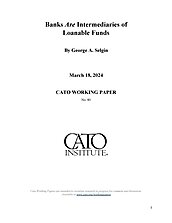Some bad ideas are as hard to kill as crabgrass. In the field of monetary economics, the real-bills doctrine is a notorious example (Humphrey 1982; Laidler 1983). Less notorious, but no less obnoxious, is the claim that banks aren’t financial intermediaries. Those who say so maintain that, instead of having to finance their lending by borrowing from others, as genuine intermediaries must, banks create all the funding they need “out of thin air.” James Tobin (1963) once called this the “Fountain Pen” theory of banking, alluding to its implication that bankers only needed fountain pens to be able to “write up” as many loans as they liked. Since fountain pens are themselves no longer used in granting credit, let’s just call it the “Thin Air” theory.
This essay defends the supposedly naïve “Intermediation” theory of banking against its lately de rigueur “Thin Air” rival. It holds that the Intermediary theory of banking comes much closer to describing the workings of actual banking systems than the Thin Air alternative.
In making this case, there are several points about the Intermediary theory I find it especially necessary to stress. They are:
- That the difference between it and the Thin Air theory is not a matter of “mere semantics”: both theories rely upon essentially the same understanding of what it means to say that banks are intermediaries, so that the difference between them is substantive;
- that the Intermediary theory doesn’t suppose that banks must receive deposits of “physical” stuff (e.g., commodity money or fiat currency) to make loans, or (for that matter) that they ever have to deal in physical stuff at all, whether by taking it in or by handing it out;
- that it is not contradicted by the fact that banks can “create” money in the form of their own transferable IOUs, and specifically in the form of current deposit account balances, or by the fact that the quantity of bank-created money at any time tends to be much larger than the quantity of base or high-powered money;
- that it doesn’t require that banks rely exclusively upon retail deposits for funding;
- that it doesn’t require that banks have sufficient funds of any sort on hand before they arrange loans;
- that it is not the same thing as the textbook “multiplier” account of bank lending and deposit creation;
- that it does not apply to fiat-money issuing central banks, the powers of which are more or less those that the Thin Air theory wrongly assigns to ordinary (commercial) banks.

